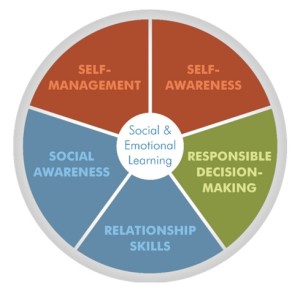Think how digital spaces, homes, schools, workplaces and everywhere else we human beings congregate would change were every child to be kindly, respectfully taught the following skills:
-

The 5 social competencies – CASEL.org Self-awareness: The ability to 1) recognize emotions and thoughts and how they affect behavior and 2) assess one’s strengths and limitations
- Self-management: The ability to regulate emotions, thoughts, and behaviors in different situations.
- Social awareness: The ability to 1) see from or take other people’s perspectives, 2) empathize with people of other backgrounds and cultures, 3) understand social and ethical behavioral norms, and 4) recognize family, school, and community resources and supports (and I’d add the ability to ask for help when needed).
- Social skills: “The ability to establish and maintain healthy and rewarding relationships with diverse individuals and groups,” which includes these skills: “communicating clearly, listening actively, cooperating, resisting inappropriate social pressure, negotiating conflict constructively, and seeking and offering help when needed.”
- Responsible decision-making: The ability to make constructive and respectful choices about one’s behavior and social interactions, factoring in ethical standards, safety concerns, social norms, evaluation of potential consequences, and the well-being of self and others.
Those are the social literacy skills – described by CASEL, the Chicago-based Collaborative for Academic, Social and Emotional Learning – and taught in at least 25,000 US schools. Can we get SEL into all schools? Think what it would do for “school climate” and staff as well as students.
Think what it would do for “Noah,” a high school student who’s the protagonist in a 17-minute short film that just premiered at the Toronto Film Festival. “Noah’s emotions seem to be entirely bound up in social media; these online interactions are the source of both his angst and his relief,” wrote Betsy Morais in The New Yorker. How self-awareness and social skills and awareness would’ve helped the student portrayed in the film.
Evidence-based outcomes
Social-emotional learning helps to “lower the levels of emotional distress,” according to CASEL, while increasing social skills and improving attitudes about oneself and others. “SEL is also associated with significant improvements in students’ academic performance and attitudes toward school.” It also “helps students become good communicators, cooperative members of a team, effective leaders, and caring, concerned members of their communities. It teaches them how to set and achieve goals and how to persist in the face of challenges.”
Can you see what this kind of training would also do for bullying prevention? It’s intuitive when we take just a little time to think about it. But in case anyone doesn’t see it, I double-checked with University of Nebraska psychologist Sue Swearer, with whom I and others worked on some bullying prevention resources for educators. She confirms that SEL actually represents the major part of bullying prevention. And – unlike many bullying-focused resources – there is already a great deal of evidence that it works, that SEL has the outcomes described above. CASEL documents that and lists all the properly evaluated SEL programs in its site.
So given that…
- There’s a full array of personal and social skills and other benefits from SEL
- The pressures on students and teachers are not decreasing
- Our media are social and user-driven so…
- Safety and wellbeing in social media is, well, social – a shared experience and sometimes a negotiation
- A national task force on Internet safety found bullying and harassment to be the most common risk in social media and reported that a child’s psychosocial makeup and home and school environments are better predictors of online risk than any technology a child uses
- Social literacy reduces the risk of (and harm from) social aggression
- We live in an increasingly connected, complex world that is increasingly…
- Demanding collaborative, cross-functional problem-solving…
Is there any reason to delay getting social-emotional learning to every child who goes to school? This is social literacy – just one of the literacies needed to live and work effectively and successfully not only in today’s very social media but also in today’s networked world. Our children’s world. It’s time to get on with this!
Related links
- “Social Media, the Social Mind and Social Thinking” in social literacy educator Michelle Garcia Winner’s “Social Thinking” blog
- “School anti-bullying programs ineffective,” a commentary in the Hartford Courant co-written by Yale University psychologist Marc Brackett
- “There are no bullies” in Tolerance.org
- “A Connecticut school to its students: We trust you”
- “Cyberbullying in grades 3-5: Important study”
- “Social literacy up, social problems down in Chicago schools”
- “Invaluable social literacy lessons from an anti-bullying conference”
- “What is bullying & what can be done about it: Lit review”
- Related and later added to these links: “Balancing external with internal Internet safety ‘tools’“

[…] of social and emotional learning (SEL), which is being taught in more and more US schools, thankfully. So even if kids aren’t learning this skill from their parents, increasing numbers of them are […]